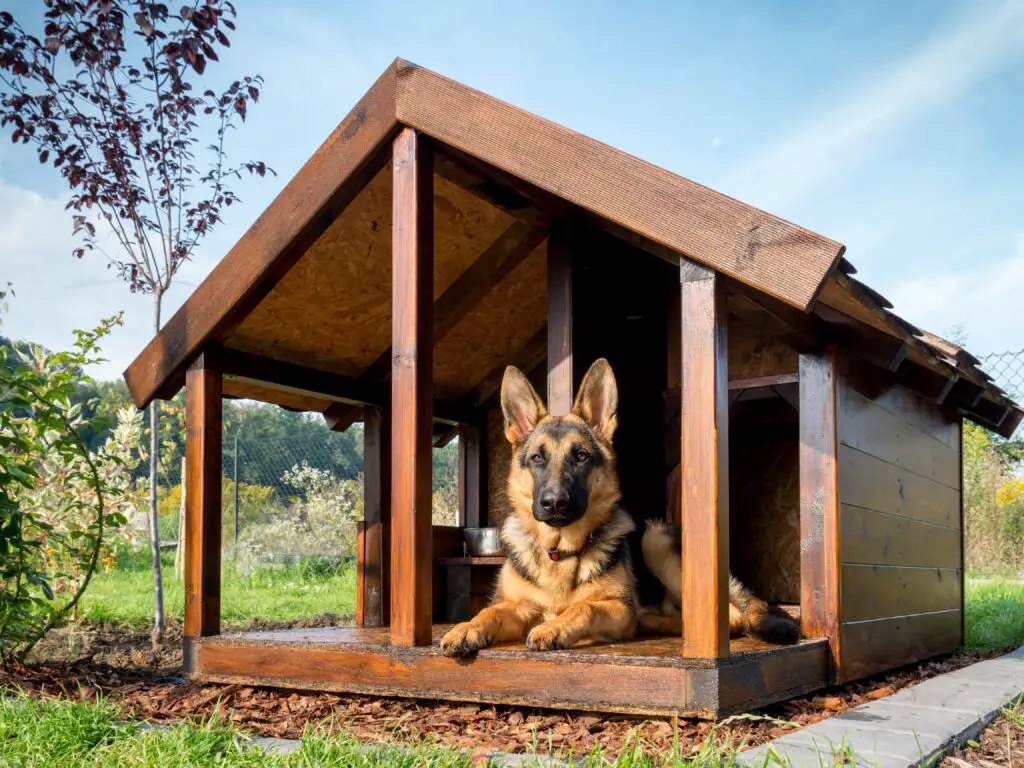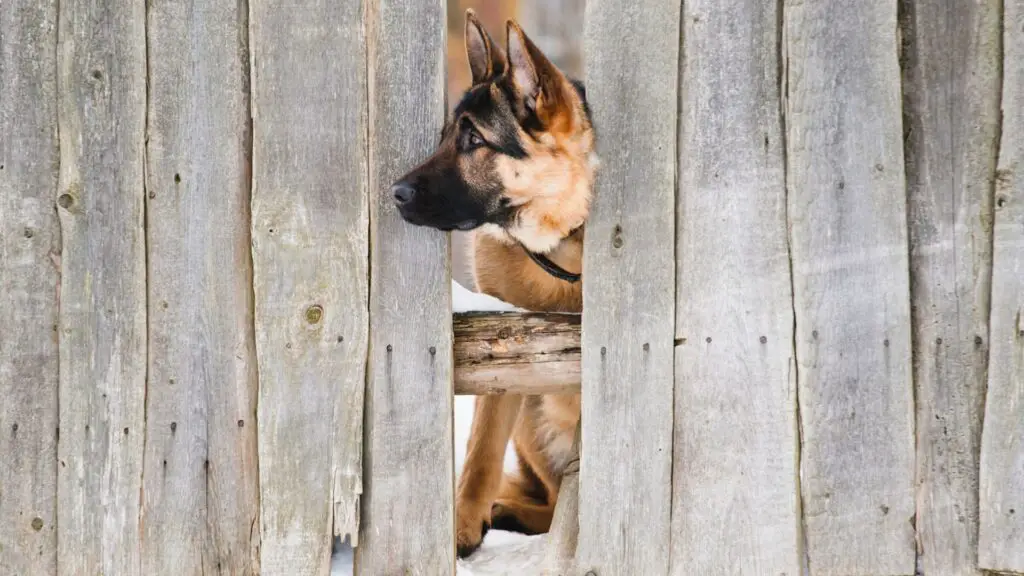The German shepherd or the Alsatian dog is the second most popular breed of dog. This breed of dog is intelligent, loyal, and fun to have.
Captain Max von Stephanitz bred this medium-sized dog for herding purposes. Additionally, this multipurpose dog full of intelligence and keen senses of smell has found favor among police and armed forces over the years.
Also, when it comes to size, the GSD is a medium-sized breed. That said, by the end of this article, you will have understood how big a female or a male GSD could get either during puppyhood or adulthood.
So, if you have been wondering how big a German shepherd can get, you are in the right place.
How Big Can a German Shepherd Get?
As earlier discussed, the German shepherd is not one of those giant breeds of dogs. In the absence of any life-limiting health conditions, here is how big a German shepherd can get.
Note, the measurements are according to the breeding standards of this dog.
Length of a German Shepherd
Measure the length of your German shepherd from the withers to the tail.
Male German shepherd
24-26 inches (60 cm-65 cm)
Female German shepherd
22-24 inches (55 cm- 60 cm)
When it comes to size, male German shepherds are longer than their female counterparts.
Weight of the German shepherd
Below are the average weights you can expect from your dog.
Males – 80lbs
Females – 65 lbs.
Worth to note, always consult your vet to whether your GSD is at the right weight.
The shepherd male dog and female have different weights and heights (sexually dimorphic).
The key to note is that the GSD is longer than the taller. That is, the length and the height ratio should be 10: 8.5.
Additionally, the above variables can vary. However, if you’re concerned about your shepherd’s weight, always consult your vet.
How Big Can German shepherd Puppies Get?
The German shepherd can have a litter of 8-12 puppies. When it comes to their growth rate, it may vary. Similar to humans, dogs have individual growth rate.
Height
Unlike other breeds of dogs, the GSD has a slow rate of growth. However, by the end of 12 months, most of the development is almost through.
So this growth chart will help you man your puppy development.
| Age | Male | Female |
| One month | 15 cm | 13 cm |
| Three months | 27 cms | 25 cm |
| Five months | 41 cms | 37 cm |
| Seven months | 52 cm | 49 cm |
| Nine months | 60 cm | 55 cm |
| 11 months | 62 cm | 59 cm |
| 12 months | 63 cm | 60 cm |
Weight
Similar to height, male and female GSDs have a difference in weight. Thus this weight chart will illustrate different changes of weight as you puppy translations to adulthood.
| Age | Male | Female |
| One month | 4 KGs | 3.5 KGs |
| Three months | 14 KGs | 12 KGs |
| Five months | 23 KGs | 20 KGs |
| Seven months | 29 KGs | 24 KGs |
| Nine months | 32 KGs | 27 KGs |
| 11 months | 34 KGs | 29 KGs |
| 12 months | 36 KGs | 31 KGs |
Don’t overfeed your dog for it to hit certain weights and heights.
Stages of Maturity of the Shepherd Dog
The shepherd dog won’t grow big instantly; it will take some time depending on the diet and its health status.
These stages will guide you on how a German shepherd develops down from puppyhood to adulthood.
Neonatal Stage
The neonatal period occurs between the first two weeks. It’s during this period that the newborn puppy is helpless. The reason being it is blind and deaf; however, the taste and touch senses are alive. Often the birth weight is 600 grams at maximum.
Transitional Stage
The transitional period occurs between the second and the fourth week.
Eyes now become open, and the puppy can now hear. The puppy will start exploring its surroundings by wobbling around.
Socialization Stage
Socialization period happens between the third week, to the third month.
Puppies can now start eating soft food. It’s during this stage you can start obedience training on this perfect companion, the shepherd dog. Additionally, it’s during this period that the dog will learn various socialization skills on how to react to different environments.
Training your dog necessary skills will shape his future personality, so keep a close eye on your dog during this period.
Juvenile Stage
The juvenile period occurs between the third and the sixth month; this period has rapid growth spurts. The puppy is utmost reliant on itself and very active. At this point, half of the development is complete almost done.
Adolescent Stage
The period between the sixth months and 18 months and the growth is almost complete. Additionally, it is the sexual maturity period.
During this phase, you can either spay or neuter your shepherd dog if you don’t intend to become a breeder. What’s more, during this period, the shepherd dog is 75% of the recommended adult size. You can now start translating your dog from puppy food to adult food.
Maturity (Adult Period)
A German shepherd will become entirely big when it hits the ages of 36 months. The dog now is 100 % of the adult weight and length.
German shepherd Mix Size
If you are fun of mixed dogs, then perhaps you should read this. Having a crossbreed of a German shepherd as a pet is lovely besides having a less susceptible dog to illness.
Similar to other breeds, every mix carries the genes of the more assertive parent. Below are the various breed mixes of the German shepherd and their sizes.
Siberian Shepherd Dog
This mixed dog is a crossbreed between a German shepherd and the Siberian husky. This mixer can grow at heights of 24 inches and reach a weight of 70 pounds.
As expected, the weight and height are similar since both the Siberian husky and the shepherd have identical sizes.
Shug
A shug is a mix between a pug and a German shepherd.
The pug is smaller than the shepherd, so the chances of having a smaller mixer dog are high. Heights can range from 12 to 15 inches and weigh 30 pounds. If you need an apartment pet with some of the German shepherd personalities, the Shug should be your number one choice.
Corman
This Corman dog, a mix between a corgi and the German shepherd. This breed is bigger than the shug. It can weigh between 40-65 pounds and reach heights of 15 inches.
Golden Shepherd
The golden shepherd is a result of crossbreeding the shepherd dog and the golden retriever. Utmost the breed will have identical weight and height variables as the German shepherd.
Heights of 25 inches and weighs 65 pounds.
Shollie
The shollie is a modern breed mix between a German shepherd and the Border collie. On average, expect to have a breed with heights of 25 inches and a weight of 80 pounds.
Rottweiler Shepherd
As per how the name suggests, this mix results from crossbreeding a German shepherd and a Rottweiler. This dog is the biggest of all breed mixes of the shepherd.
On average, the dog can weigh 90 lbs. And reach heights of 29 inches.
Depending on your energy levels and the space you have, you can decide which of the above mixes you can adopt. In case you want a smaller version of a furball, you can choose a shug, but if you need a strong guard dog, choose to have the Rottweiler-shepherd dog.
How to know whether your shepherd dog is at the healthy weight
A German shepherd should not be thin or obese; thus, be keen on what you feed him. Additionally, overfeeding may predispose your dog to health effects related to obesity.
An underweight dog is thin and has its ribs, spine, and pelvic bone protruding, and they are very much visible. Additionally, you can easily tell the waist and feel it.
Consequently, an obese German shepherd has a waist that is not clearly defined. Furthermore, the spine, ribs, and pelvic bones are not easily felt since they are hidden under the fat.
A German shepherd with an ideal size will have a clearly defined and well-proportioned waist. Additionally, the ribs, spine, and pelvic bones can easily be felt under the fat.
Underweight Dog
Various factors can cause a dog to be underweight. Two main factors are diet and health conditions.
To help the underweight German shepherd, you can-
- Treat any underlying condition, like diabetes.
- Feed your small dog with high-quality dog food. Consider a healthy diet consisting of high-protein foods, carbohydrates, lots of vitamin D and a few fatty acids.
- Remove or treat parasites that are draining your pet.
- Give your dog food frequently.
Helping Your Overweight Dog
An obese dog like the GSD is at risk of hip and elbow dysplasia and cardio-vascular diseases. A fat Dog will barely enjoy its life as most of the organs are strained. However, you can salvage the situation by following the below guides.
- Feed your dog less food or even divide meals into three
- Let your dog feed on quality food-
- Regular exercise- an obese dog can be hard to exercise, but you can still use positive reinforcements to get your dog excited about training and exercises. Worth to note, don’t apply intense exercises on your fat GSD.
- Treat the underlying health conditions causing the obesity rapid weight gain can be a symptom of an underlying health problem like Cushing’s syndrome and hypothyroidism.
When Is the German shepherd Considered Grown?
The German shepherd reaches its peak of growth between the 5th and 12th month. By the 18th month, he has already grown a considerable amount, and by 36 months, he has reached his full height and adult weight.
Key points: don’t push or accelerate the growth of your German shepherd unless advised by the vet. Remember, some puppies may take a shorter time to grow, while others may take longer fully.
Working Dogs or the Show Dogs, Which One Is Bigger
The working dog and the show line GSD have different sizes.
When it comes to thickness and height, the working dogs are the biggest. This breed is built for strength. This dog has lean muscle and a straight back that enable it to work for a long.
Consequently, the show line dogs are small and thinner than working dogs. Famously of their leaned backs and short legs.
This breed of dog is bred for its looks. Because of its slopped nature of the back legs, this breed of dog is susceptible to hip dysplasia and degenerative myelopathy.
Don’t buy from a breeder who breeds for looks. For example, a genuine or a minded breeder will interbreed a large with a small GSD to give forth a shepherd that conforms to the shepherd dog breed standard.
How Often Should I Measure How Big My Shepherd Is?
For weight, you can measure your GSD every two months and ensure you weigh their weight on an empty stomach.
For the height, take measurements once per 1 month.
The Importance of Knowing How Big Is My GSD
A responsible dog owner always takes keen on the size of his shepherd dog. The size will determine whether your pet has any health issues.
The exit
Hoping now, you have learned how big a German shepherd can get, whether it’s a female or a male. However, don’t be frustrated in case your dog doesn’t reach the exact weights and length.
Consequently, if you are concerned about your shepherd size, consider visiting your vet for a health checkup.





